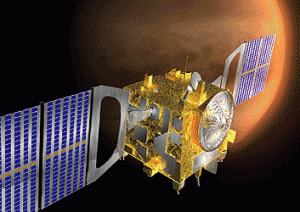Lightning strikes Venus (original) (raw)
By Lisa Potter
The Venus Express’s magnetometer measured electromagnetic waves, called whistler waves, which confirmed the presence of lightning on Venus. After eight-plus years in orbit, the spacecraft ended its mission.
Credit: NASA
Scientists have detected electromagnetic signals emanating from Venus’s thick cloud layer, bolstering the case for lightning on the planet.
The Venus Express spacecraft, which recently ended its mission after eight years, recorded electromagnetic pulses about 217 miles (300 kilometers) above the planet’s surface, said Richard Hart, a graduate student at the Institute for Geophysics and Planetary Physics at the University of California at Los Angeles.
Hart said the findings, presented Wednesday at a poster session at the American Geophysical Union’s Fall Meeting in San Francisco, provide additional evidence that there is lightning on Venus.
For decades, Venus has teased scientists about whether her atmosphere produces lightning. Geophysicist Christopher Russell of University of California at Los Angeles, Hart’s advisor, used low-frequency electromagnetic imprints in the air, called whistler waves, as evidence for lightning, but some in the community remain skeptical.
“A big question has been whether there is lightening on Venus. It has all those clouds, you’d think there’d be storms,” said Ron Thomas, a lightening researcher at New Mexico Tech who is unaffiliated with the study. “You have to look really hard to find the right signals.”
When lightning flashes on Earth, it leaves waves, similar to the way clapping hands produce sound waves, Hart explained. Radios can pick up the wave’s frequency, which is how whistler waves got their name.
“During World War I, soldiers were hearing a whistler sound over the radio,” said Hart, mimicking the sound. “They thought they were hearing grenades in the air.”
During thunderstorms, ice particles in the clouds bump into each other. On Earth, the particles are water ice and on Venus, these particles are sulfuric acid-ice. With each collision, the ice particles’ atoms exchange electrons. When an atom loses an electron, it takes on a positive charge. If the atom gains an electron, it becomes negatively charged. At a certain point, the ice-filled clouds cluster into mostly positive- or mostly negative-charged masses. When the charge difference between two nearby clouds is large enough, they will release a pulse of energy and lightning strikes.
Hart analyzed signals detected by the Venus Express spacecraft between October 2010 and the end of December 2013, or about five Venus years.
Hart looked as thoroughly as he could to find and describe the right signals — the whistler waves. Lightning likely occurs in Venus’s cloud layer, about 30 to 43 miles (50 to 70 kilometers) above the surface and then travels along the planet’s magnetic field, where the Venus Express spacecraft picks them up mostly at 125 and 217 miles (250 to 300 kilometers) above the surface, Hart explained.
The spacecraft recorded more than 70 percent of the lightning signals while orbiting at this altitude, indicating this is the most efficient height for electromagnetic wave detection.
Hart said the study could help determine the most effective orbit for future Venus missions.
Hart has hope that a proposed Venus mission, Veritas, will yield much more striking data for Venus lightning. If approved, Veritas will maintain a circular orbit that will stay in the 125 and 217 miles (250 to 300 kilometer) range 24 hours per day. The VEX spacecraft has a 24-hour, elliptical orbit and only gets close enough to Venus’s surface as it passes near the north pole, spending only a total of 10 minutes within wave-detecting range per orbit.
Lisa Potter is a science communication graduate student at UC Santa Cruz.
